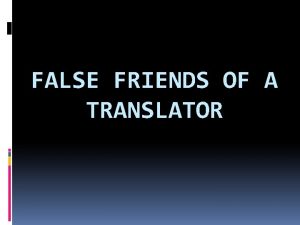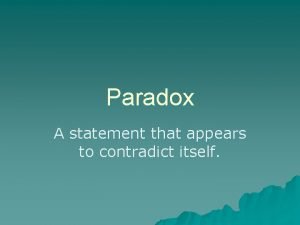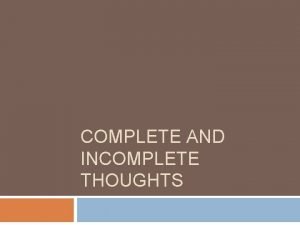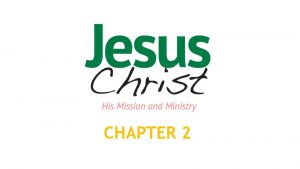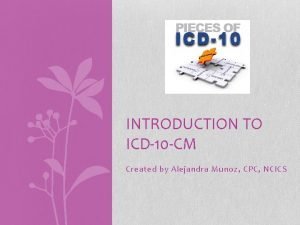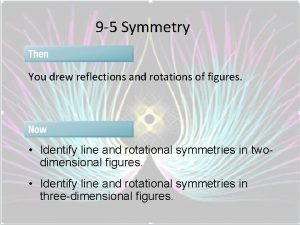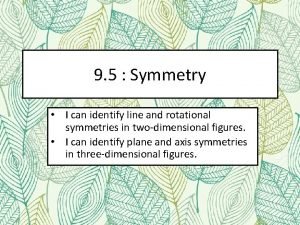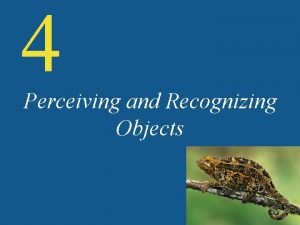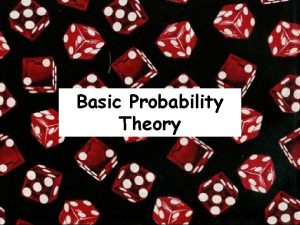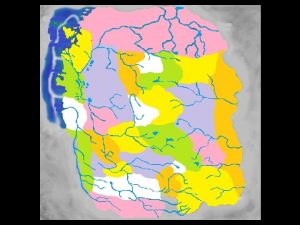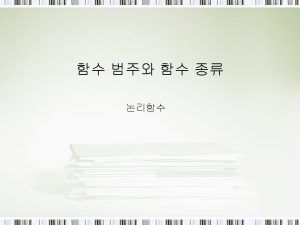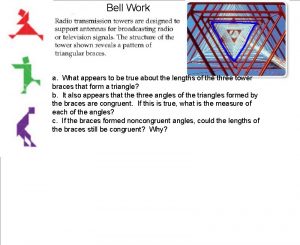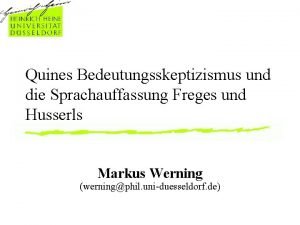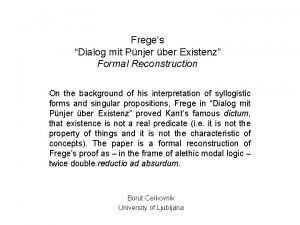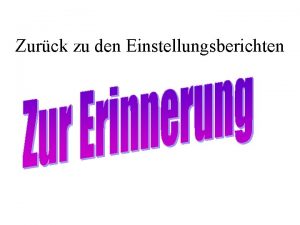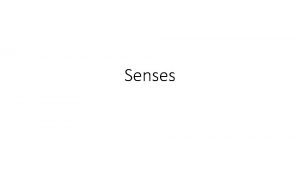Freges The Thought Meaning of true Grammatically appears












- Slides: 12

Frege’s “The Thought” • Meaning of “true” – Grammatically appears as an adjective – So a thing cannot be true, but a picture or idea about it might be The thing cannot be “true” A picture or idea about it can be It looks like Truth requires a relation between two things and is determined by whether they correspond

Frege’s “The Thought” • So you assume truth has something to do with correspondence, it’s a relation between two things • But “true” is not a relation word, it’s an adjective. It contains no reference to anything else two which something must correspond – If you don’t know what the picture or idea is meant to represent, you don’t know to what you should compare it to determine truth – Strictly speaking, for two things to correspond, they would need to be identical, and thus be the same thing

Frege’s “The Thought” • What we want to say is that our ideas correspond to reality in some way and are true – Not that they are identical, but that they correspond in some respect or other – But looking at any particular respect, you’d have to define characteristics and the same criticisms above would apply • Correspondence theory collapses

Frege’s “The Thought” • So Truth isn’t about the correspondence of things and pictures or ideas • Any time the question of truth comes up, one refers to a sentence = Picture/Idea = “My idea corresponds to the Cathedral” Sentence What we mean when we say the truth of an idea or picture is really the truth of a sentence

Frege’s “The Thought” • A sentence is just a series of sounds (or marks) with a sense • When we talk about the truth of a sentence, we really mean the truth of its sense • Big point: The truth of the sense of a sentence doesn’t consist in correspondence to anything else (or else endless regression) Written sentence Sense of sentence Picture/Idea Spoken sentence Truth

Frege’s “The Thought” • Frege uses the term “thought” to describe the sense of a sentence • It is not material, but ‘clothed’ in the material and perceptible (which are excluded from sphere of truth) • Truth is not a property of things, though properties of things are joined to truth in the property of a thought – “I smell violets” = “It is true that I smell violets”

Frege’s “The Thought” • Not all sentences have senses which are thoughts in Frege’s meaning: – Imperative = no – Declarative = yes – Exclamatory = maybe • If they communicate something agreed upon = yes • Venting feelings = no – Interrogative = maybe • Word questions = no “Why? ”, “When? ” • Yes/No questions = yes “Are you daft? ”

Frege’s “The Thought” • In sentences that express thoughts, there are two components: the content and the assertion – The content = the thought – The assertion = laying the thought out as true • So [kind of a jump here] – Apprehension of a thought = thinking – Recognition of the truth of a thought = judgment – Manifestation of this judgment = assertion Side note: sentences can also contain a third component that acts on the feelings, which isn’t part of content, but somehow relates to assertive style

Frege’s “The Thought” • Language is complicated – Stress during assertion can aid understanding (emphasis, word order, etc. ) without altering thought – He says “content” can go beyond thought, but I think he means assertion can go beyond thought – Sometimes assertion isn’t sufficient to convey thought – Sometimes thought is different for same assertion coming from different people

Frege’s “The Thought” • • People have their own inner world of senseimpressions, imagination, sensations, moods, inclinations, etc. Frege calls these “ideas”. Wholly interior & subjective, not part of independent, external world – – • Ideas cannot be seen, smelled, tasted, touched, heard Ideas are had Ideas need a bearer (same as #2? ) Every idea has only one bearer Question: is a thought an idea? (you should know the answer, but see the next slide…)

Frege’s “The Thought” • Thoughts ≠ Ideas – Two people can have the same thought, e. g. Pythagorean Theorem: x 2 + y 2 = z 2 – If every thought needed one and only one bearer, then there could be no shared thoughts, i. e. science, knowledge, etc. • Frege’s conclusion: thoughts are not ideas, nor are they part of the material, external world • Oooooohhh, snap!

Frege’s “The Thought” • Guess what this distinction gets you? – Defeat of idealism: ideas are not the only objects for consciousness – Defeat of radical skepticism: if you can apprehend something of which you are not the ‘bearer’ or producer, then there is something outside you – Problem of identity: if there were only ideas, the “I” would be an idea only. Thoughts allow one to distinguish between my thought of myself and the thing having the thought – Problem of solipsism: if I can identify myself as a bearer of independent thought, I can recognize others as the same • Was für ein Gedanke!
 Grammatically parallel
Grammatically parallel False friends of translator
False friends of translator Example of paradox
Example of paradox Incomplete and complete thoughts
Incomplete and complete thoughts 102 dr
102 dr Chapter 2 jesus christ true god and true man
Chapter 2 jesus christ true god and true man The point dash signals to the coder that
The point dash signals to the coder that State whether the figure appears to have line symmetry
State whether the figure appears to have line symmetry Which clouds have the greatest turbulence
Which clouds have the greatest turbulence Pnp logo and its meaning
Pnp logo and its meaning Properties of laser light
Properties of laser light State whether the figure appears to have line symmetry
State whether the figure appears to have line symmetry The moonlit world appears to be drained of color because
The moonlit world appears to be drained of color because

